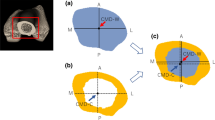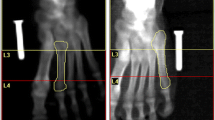Abstract
To investigate the age-related activity of the epiphyseal plates, a retrospective study of 99mTc-methylene diphosphonate bone scans was undertaken. The study comprised 81 males and 46 females aged 2 weeks to 24 years. The total percentage (%) whole-body (ratio of total physis activity to whole-body activity) and the regional % whole-body (ratio of physis activity of one region to whole-body activity) were derived. The ratio of physis activity of one region to the total physis activity was defined as % physis. Before age 12, total physis activity was found to contribute about 10% to whole-body activity. All total and regional % whole-body activities followed sigmoid curves with age. The differences of the parameters (transition centers and widths) suggested that there might be a later and longer period for the disappearance of physis activity in males than in females. For all the regions, % physis changed little with age until after puberty. At age <1, the proportion of bone activity in the body was about 30–35% for skull, 20–25% for lower limbs, and 5–15% for the rest of the regions. The maximal changes during growth occurred in the skull and the lower limbs. The age-related changes of physis activity during growth reflect a combination of the potential of bone to grow and the processes of bone growth and bone turnover. Bone scintigraphy is useful in understanding the changes of physis activity during growth.



Similar content being viewed by others
References
Van Der Eerden BC, Karperien M, Wit JM (2003) Systemic and local regulation of the growth plate. Endocr Rev 24:782–801
Kronenburg HM (2003) Developmental regulation of the growth plate. Nature 423:332–336
Isaksson OG, Jansson JO, Gause IA (1982) Growth hormone stimulates longitudinal bone growth directly. Science 216:1237–1243
Le Roith D, Bondy C, Yakar S, Liu JL, Butler A (2001) The somatomedin hypothesis. Endocr Rev 22:53–74
Baron J, Klein KO, Colli MJ, Yanovski JA, Novosad JA, Bacher JD, Cutler GB Jr (1994) Catch-up growth after glucocorticoid excess( a mechanism intrinsic to the growth plate. Endocrinology 135:1367–1371
Martin EA, Ritman EL, Turner RT (2003) Time course of epiphyseal growth plate fusion in rat tibiae. Bone 32:261–267
Pritchett JW (1992) Longitudinal growth and growth-plate activity in the lower extremity. Clin Orthop Relat Res 2:274–279
Pritchett JW (1991) Growth plate activity in the upper extremity. Clin Orthop Relat Res 1:235–242
Jaramillo D, Villegas-Medina OL, Doty DK, Rivas R, Strife K, Dwek JR, Mulkern RV, Shapiro F (2004) Age-related vascular changes in the epiphyseal, physis, and metaphysis: normal findings on gadolinium-enhanced MRI of piglets. AJR Am J Roentgenol 182:353–360
Stevens DG, Boyer MI, Bowen CV (1999) Transplantation of epiphyseal plate allografts between animals of different ages. J Pediatr Orthop 19:398–403
Guillemart A, Besnard JC, Le Pape A, Galy G, Fetissoff F (1978) Skeletal uptake of pyrophosphate labeled with technetium-95m and technetium-96, as evaluated by autoradiography. J Nucl Med 19:895–899
Guillemart A, Le Pape A, Galy G, Besnard JC (1980) Bone kinetics of calcium-45 and pyrophosphate labeled with technetium-96: an autoradiographic evaluation. J Nucl Med 21:466–470
Dimeglio A (2001) Growth in pediatric orthopedics. In: Morrissy RT, Weinstein SL (eds), Lovell and Winter’s Pediatric Orthopedics, 5th ed. Lippincott Williams & Wilkins, Philadelphia, pp 54–58
Parfitt AM (2002) Misconceptions (1): epiphyseal fusion causes cessation of growth. Bone 30:337–339
Roach HI, Mehta G, Oreffo RO, Clarke NM, Cooper C (2003) Temporal analysis of rat growth plates: cessation of growth with age despite presence of a physis. J Histochem Cytochem 51:373–383
Kigami Y, Yamamoto I, Ohnishi H, Miura H, Ohnaka Y, Ota T, Yuu I, Masuda K, Morita R (1996) Age-related change of technetium-99m-HMDP distribution in the skeleton. J Nucl Med 37:815–818
Israel O, Lubllshitzky R, Frenkel A (1994) Bone turnover in cortical and trabecular bone in normal women and women with osteoporosis. J Nucl Med 135:1155–1158
Author information
Authors and Affiliations
Corresponding author
Rights and permissions
About this article
Cite this article
Yang, KT.A., Yang, A.D. Evaluation of Activity of Epiphyseal Plates in Growing Males and Females. Calcif Tissue Int 78, 348–356 (2006). https://doi.org/10.1007/s00223-005-0269-3
Received:
Accepted:
Published:
Issue Date:
DOI: https://doi.org/10.1007/s00223-005-0269-3




